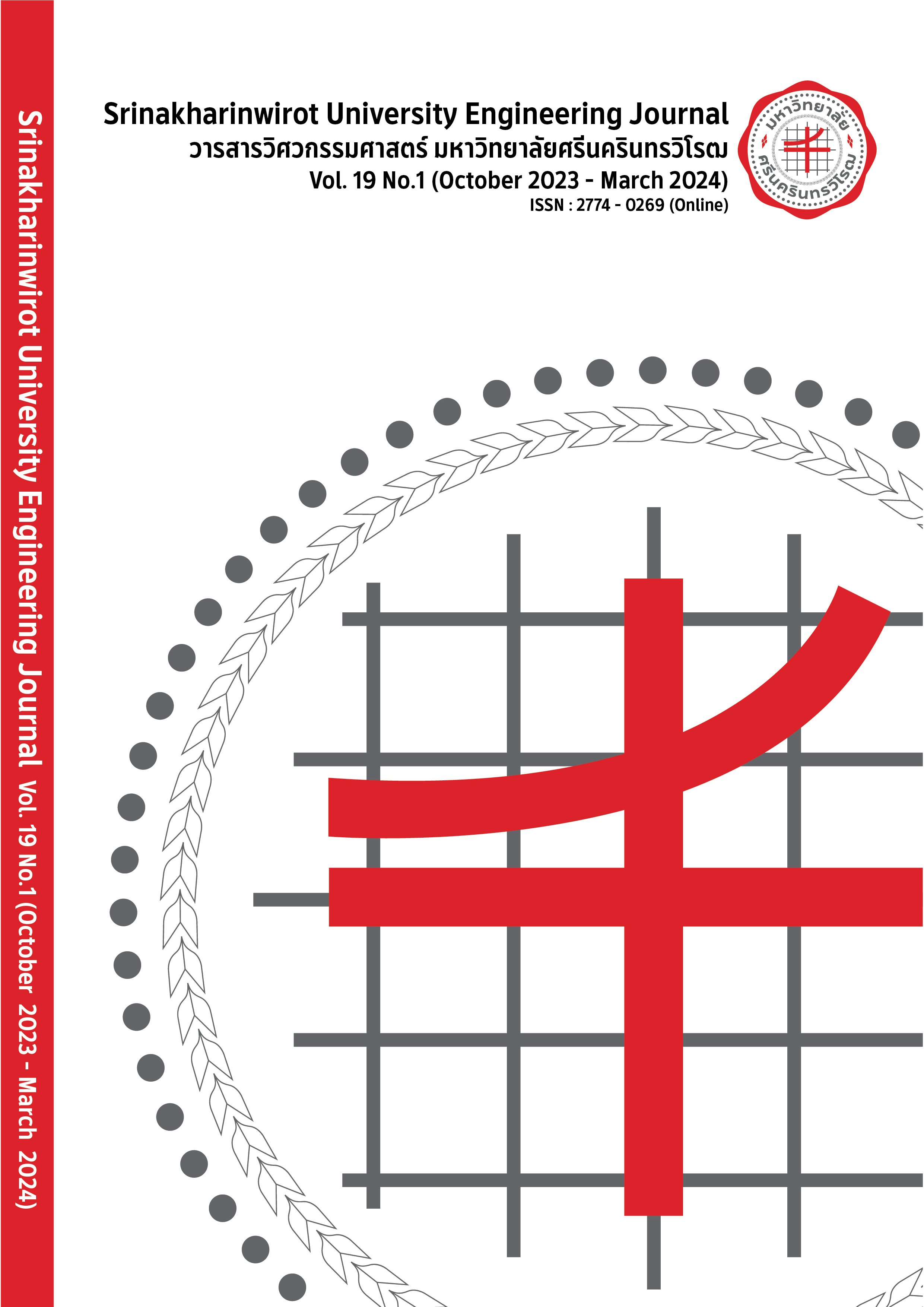Decolorization of Acid Dye in Aqueous Solution by a Combined Adsorption–Ozonation Process
Main Article Content
Abstract
This research aimed to study the decolorization and degradation of acid yellow 36 in an aqueous solution by comparing three different processes: adsorption on activated alumina prepared from aluminum packaging scrap, oxidation with ozone, and a combination of adsorption and ozone oxidation. The effects of pH, initial dye concentration, adsorption time, and ozonation time were investigated. The results showed that activated alumina adsorption and ozone oxidation with a single process could remove 98.2% and 97.5% of the dye concentration and reduce the COD by 95% and 65%, respectively, in 50 minutes. The ozone oxidation process could effectively remove the dye concentration but reduce the COD less than adsorption. When using a combination process between adsorption and ozonation in a three-phase system at acidic conditions within 20 min, achieved 98.7% removal of acid dye and a 60% reduction of the COD from 160 mg/L to 64 mg/L. The kinetics of the acid yellow 36 removal were studied. It was found that the combined process corresponded to the pseudo-second-order reaction with a higher rate constant than the pseudo-second-order reaction of the single process. The combined process can be used as an alternative method to effectively reduce the wastewater treatment time.
Article Details

This work is licensed under a Creative Commons Attribution-NonCommercial-NoDerivatives 4.0 International License.
Copyright belongs to Srinakharinwirot University Engineering Journal
References
F. I. Hai, K. Yamamoto and K. Fukushi, “Hybrid treatment systems for dye wastewater,” Critical Reviews in Environmental Science and Technology, vol. 37, no. 4, pp. 315–377, May 2007.
doi: 10.1080/10643380601174723.
P. K. Malik, “Use of activated carbons prepared from sawdust and rice-husk for adsorption of acid dyes: a case study of Acid Yellow 36,” Dyes and Pigments, vol. 56, no. 3, pp. 239–249, Mar. 2003,
doi: 10.1016/s0143-7208(02)00159-6.
S. Banerjee, S. Dubey, R. K. Gautam, M. C. Chattopadhyaya and Y. C. Sharma, “Adsorption characteristics of alumina nanoparticles for the removal of hazardous dye, Orange G from aqueous solutions,” Arabian Journal of Chemistry, vol. 12, no. 8, pp.5339–5354, Dec. 2019, doi: 10.1016/j.arabjc.2016.12.016.
J. Basiri Parsa and S. Hagh Negahdar, “Treatment of wastewater containing Acid Blue 92 dye by advanced ozone-based oxidation methods,” Separation and Purification Technology, vol. 98, pp.315–320, Sep.2012, doi: 10.1016/j.seppur.2012.06.041.
K. Turhan and S. A. Ozturkcan, “Decolorization and degradation of reactive dye in aqueous solution by ozonation in a semi-batch bubble column reactor,” Water, Air, & Soil Pollution, vol. 224, no. 1, Nov. 2012, doi: 10.1007/s11270-012-1353-8.
C. Zulzikrami Azner Abidin, M. Ridwan Fahmi, O. Soon-An, S. Nurfatin Nadhirah Mohd Makhtar and N. Rosmady Rahmat, “Decolourization of an azo dye in aqueous solution by ozonation in a semi-batch bubble column reactor,” ScienceAsia, vol. 41, no. 1, p. 49, 2015, doi: 10.2306/scienceasia1513-1874.2015.41.049.
B. Karwowska, E. Sperczyńska and L. Dąbrowska, “Water treatment in hybrid connection of coagulation, ozonation, UV Irradiation and adsorption processes,” Water, vol. 13, no. 13, p. 1748, Jun. 2021, doi: 10.3390/w13131748.
J. Wang and H. Chen, “Catalytic ozonation for water and wastewater treatment: Recent advances and perspective,” Science of The Total Environment, vol. 704, p. 135249, Feb. 2020, doi: 10.1016/j.scitotenv.2019.135249.
A. Ikhlaq, M. Raashid, A. Akram, M. Kazmi and S. Farman, “Removal of methylene blue dye from aqueous solutions by adsorption in combination with ozonation on iron loaded sodium zeolite: role of adsorption,” Desalination and Water Treatment, vol. 237, pp. 302–306, 2021, doi: 10.5004/dwt.2021.27744.
P. C. C. Faria, J. J. M. Órfão and M. F. R. Pereira, “Mineralisation of coloured aqueous solutions by ozonation in the presence of activated carbon,” Water Research, vol. 39, no. 8, pp. 1461–1470, Apr. 2005,
doi: 10.1016/j.watres.2004.12.037.
W. Pratarn, T. Pornsiri, S. Thanit, C. Tawatchai and T. Wiwut, “Adsorption and Ozonation Kinetic Model for Phenolic Wastewater Treatment,” Chinese Journal of Chemical Engineering, vol. 19, no. 1, pp. 76–82, Feb. 2011, doi: 10.1016/s1004-9541(09)60180-4.
J. I. Lombraña, A. Menéndez, N. Villato, A. De Luis, and C. Rodriguez, “Kinetic modeling of the operational variants in a batch Ozonation-adsorption process,” in 15th International Conference on Environmental Science and Technology, Rhodes, Greece, 2017, pp. 390-394.
C. Ferreiro, A. de Luis, N. Villota, J. Lomas, J. Lombraña and L. Camarero, “Application of a combined adsorption−ozonation process for phenolic wastewater treatment in a continuous fixed-bed reactor,” Catalysts, vol. 11, no. 8, p. 1014, Aug. 2021, doi: 10.3390/catal11081014.
A. Ikhlaq, T. Aslam, A. M. Zafar, F. Javed, and H. M. S. Munir, “Combined ozonation and adsorption system for the removal of heavy metals from municipal wastewater: effect of COD removal,” Desalination and Water Treatment, vol. 159, pp. 304–309, 2019, doi: 10.5004/dwt.2019.24164.
P. Kamthita and S. Tiamsri, “Application of response surface methodology for optimization of -alumina nanoparticles synthesis and acid dye adsorption,” Journal of Current Science and Technology, vol. 9, no. 1, pp. 1-15, Jan. 2019.
P. Maimansomsuk, “COD Analysis,” in Introduction to Water and Wastewater Analysis, Department of Industrial Works, 2010, pp. 1-19.
H. Qiu, L. Lv, B. Pan, Q. Zhang, W. Zhang, and Q. Zhang, “Critical review in adsorption kinetic models,” Journal of Zhejiang University-SCIENCE A, vol. 10, no. 5, pp. 716–724, May 2009, doi: 10.1631/jzus.a0820524.


